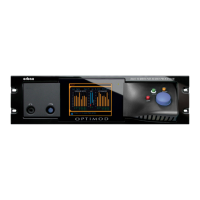OPTIMOD MAINTENANCE
4-15
Table 4-6: SDI Timing & Jitter Specifications
C) At each combination of frame rates and resolutions, verify that the AES 1/2
output’s sample rate can be locked to the SDI input signal. Note that only 32,
44.1, and 48 kHz are supported for the pull-down frame rates, while 32, 44.1,
48, 88.2, and 96 kHz are supported for the integer frame rates.
D) Apply a SMPTE 274M-compliant reference signal to the video reference input
and verify that the sample rate at AES output 1/2 can be locked to this refer-
ence. Do the same with a SMPTE 296M-compliant video reference input.
E) At each combination of frame rates and resolutions, verify that the 8685 can
delay the video signal without corruption with the maximum 15-frame delay
available in the setting of the 8685’s V
IDEO DELAY control.
F) If the optional Dolby-E decoder module is fitted, verify that a valid Dolby-E
signal applied to the 8685’s AES Input 1/2 can be decoded and routed to the
8685’s AES Output 1/2. Verify the same thing when the Dolby-E signal is re-
ceived from the SDI audio stream 1/2.
G) If the optional Dolby-E encoder module is fitted, verify that a multichannel
signal applied to the 8685’s AES3id inputs 1/2, 3/4, and 5/6 can be encoded
and routed to AES3id output 1/2.
17. Return OPTIMOD 8685 to service.
A) Remove the 620Ω resistors connected across the outputs.
B) Restore your normal operating parameters by recalling the Setup you saved in
step 1 on page 4-9: L
OCATE to RECALL/IMPORT>RECALL SETUP. Highlight the
Setup using the knob or joymouse. Then press E
NTER.
SMPTE
standard
Rise Time
(tr)
Fall Time (tf) Difference
(tr/tf)
Jitter
(Alignment)
Jitter
Timing)
259M-2008 400ps (min) 1500ps (max) 500ps (max) 0.2UI (max) 0.2UI (max)
292-2008 270ps (max) 270ps (max) 100ps (max) 0.2UI (max) 1UI(max)
424M-2006 135ps (max) 135ps (max) 50ps (max)) 0.3UI (max) 2UI (max)

